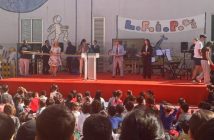
It’s rare that someone gets the chance to write their own versions of fairy tales, but that’s exactly the project Mei Lan Frame completed in 2007. Frame, who has taught students in Japan, Hawaii and Beijing, has always had a fascination with myths and tales. The writer, who is half-Chinese, moved to Beijing in 2003 and was an ESL specialist teacher at the Western Academy of Beijing. While on a Fulbright fellowship in India in 2007, she edited and contributed to two books, Chinese Fairytales and Chinese Myths, a project that allowed her to learn more about Chinese culture and be part of the long tradition of evolving stories.
Where did the idea to write Chinese Fairytales and Chinese Myths come from?
The idea came from Jo Lusby, the China representative of Penguin Group. We used to play music together (I play the flute, she plays the violin). She had these books with a very bad English translation, and she knew I had written a play about the Brothers Grimm. I took the books, edited them, and filled in a lot of gaps. We separated it into fairytales and myths.
Tell me more about your play about the Brothers Grimm.
I had written a play, “A Grimm Tale,” about the Brothers Grimm that was put on by Beijing-based Mad City Productions in 2003. We took four fairy tales and wove them into a central story. When the Brothers Grimm first compiled the original fairytales, nobody bought them because they were too dark and too scary. So they edited them and gave them nice endings. They invented the standard fairytale format of “Once upon a time” and when they did that, they changed everything.
What’s the difference between myths and fairy tales?
I think myths are based on truth – they tend to be based on an actual person and have a real place in mind. The myths, in a way, seem to give a social purpose. They define what civilization is.
Fairy tales have more themes like adventure and love. They tend to have certain characters, like princesses and demons that are clearly good and bad. In myths, it’s not as clear–a lot of the
characters who are good also suffer.
Who created these fairy tales?
Some are indigenous to a region or ethnic minority. They’re so well known that if you mention Meng Lijun crying down the Great
Wall, everyone knows what you are talking about – it’s public property.
Do you think China has a stronger fairy tale culture than other countries?
I think so because China prides itself on an older culture and civilization. A lot of these tales are repeated in chengyu, the four-character sayings. A lot of chengyu have stories behind them but we don’t tend to allude to myths in the English language. In China, linguistically, the myths and fairy tales are very much alive.
How did you decide what to change in these stories?
I had to look up all the versions. The descriptions were sometimes ridiculous so a bit of these stories are made up. There’s a bit of me in there. I like to think that I’m contributing to that long tradition of changing the story, the eternal editor that exists through many generations.
What is your favorite fairy tale?
I was always intrigued by the one about the princess who accidentally drops a golden ball into a pool of water. A frog offers to retrieve her gold ball in exchange for a life in her palace. He returns her golden ball and she runs back to the castle – her father tells her that she must honor her promise to the frog. She watches him eat off of her golden plate and drink from her golden cup and she becomes so angry that she throws him against the wall and he turns into a beautiful prince. It’s an
extremely psychological fairy tale; there are other messages in it.
Favorite myth?
I’m fascinated by Greek myths. Those have always been reflections on human nature. The gods are always too greedy or lustful and they just cause all sorts of chaos. I grew up in Orlando, Florida with Disney World, so I was bombarded with Disney TV shows and American legends. There’s a humor behind them that I really
like.
What did you learn in the process of writing these books?
There are a lot of very strong women in Chinese myths and a lot of rebellion against injustice and established order to better mankind, which I found quite interesting.
How do children learn through stories?
As a teacher, I’ve always found that children are naturally drawn to myths and fairy tales. Stories help develop multiple ways of looking at something. If you’re teaching science and math, there’s one correct answer, but in literature you can never really have a completely correct answer. There is no right or wrong in interpretation, and I find kids have such different views of looking at things in terms of importance.
Mei Lan’s books (for ages 10-13) are currently on sale at The Bookworm, Chaterhouse, Garden Books, and the Wangfujing Foreign Languages Bookstore.


